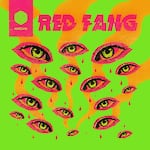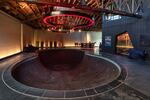For the past decade, the Portland-based outfit Red Fang has been at the forefront of a thriving metal and hard rock music scene in Oregon.
After a five-year hiatus, the band has returned with a new album called “Arrows” via Relapse Records, an effort that finds them reuniting with long-time producer Chris Funk.

"Arrows" by Red Fang
Courtesy of the artist
Although probably best known as a member of the folk-rock group The Decemberists, Funk has carved out an impressive and eclectic resume with his behind-the-scenes work. He’s currently based out of Halfling Studio in Northwest Portland, which is located on the grounds of the nonprofit Bodecker Foundation. Its building has some serious quirks, including an empty swimming pool where Red Fang’s John Sherman recorded his drumming parts for much of the album.
“The pool is there because the building was actually built by a guy called Sandy Bodecker who was the mastermind behind Nike skateboarding,” says Red Fang bassist and lead singer Aaron Beam. “So the bowl was not really put in with music in mind. But Chris had discovered from working in that space for a long time that if you put drums down in there it has this just gigantic amount of reverberation.”

Halfling Studios has an empty swimming pool designed for skateboarding. Red Fang Drummer John Sherman recorded his drums in the pool's lower bowl.
Jason Quigley
According to Beam, it’s a unique, booming echo that is nearly impossible to replicate with electronic wizardry.
“You can just get the most enormous sound imaginable,” he proudly muses about the results from unusual recording set-up.
That cacophony is on full display throughout “Arrows,” including in the album’s title track. It’s a grimy, crunchy ball of anger that showcases the best the band has to offer. For the wild, sword-themed music video that accompanies the track, the band reconnected with another long-time collaborator — music video director and former Jackass stunt mastermind Whitey McConaughey.
“He’s got a great sensibility for character and for humor and taste without like being too corny,” Beam said of the director.
Marked by off-the-wall humor and dangerous feats, McConaughey’s previous work with the band has made them viral sensations on YouTube. But despite their online fame, cult international fanbase, and critical acclaim, they still don’t grab a lot of headlines in their hometown.
Red Fang embraces that somewhat underground status.
“[M]etal is not the most accessible music — and by design in a lot of ways,” explained Beam. “It’s people who are feeling separated from society and so they make music that reflects that. And also, in some ways [it’s] an intentional distancing from mainstream society.”
OPB recently caught up with Red Fang lead singer and bassist Aaron Beam to chat about his deep love of Sub Pop (the iconic Seattle record label that launched the careers of early ’90s grunge bands like Nirvana and Soundgarden), the production process behind his band’s infamous viral music videos and more.
Jerad Walker: This record is the continuation of a long-term collaboration with producer Chris Funk, who’s also a musician and probably best known as a member of The Decemberists. I think a lot of people might be surprised to find out that he’s done high-level work with a metal band of your caliber. His work with The Decemberists is just so sonically different. How did that relationship start?
Aaron Beam: I knew Chris through his ex-wife Seann [McKeel] who I worked with when I was at the Portland Mercury many, many years ago. And just because Portland was a real small world in the late nineties and early two thousands, I’ve just known Chris through new musical connections. Yeah, he hit us up about doing a record [in 2011] and I think it took a little bit of selling to the band. But he made a pretty strong case for — it’s a rock record. You know? He’s a musician, he understands music in general, so the music that he personally plays doesn’t really make any difference whatsoever and with his ear as far as what he can hear and what he can pick out from a band like us.
Walker: And you’ve had a lot of success with him.
You recorded this new album here in Portland, correct?
Beam: Yes, we did. We recorded it at Halfling Studio up in northwest Portland.
Walker: One cool thing I read about that place is that it has a pool. And your drummer John Sherman apparently tracked his parts from inside the bowl area of the swimming pool.
Beam: Yeah.
Walker: Why?
Beam: [Laughter]
The pool is there because the building was actually built by a guy called Sandy Bodecker, who was the mastermind behind Nike skateboarding. So the bowl was not really put in with music in mind. But Chris had discovered from working in that space for a long time that if you put drums down in there it has this just gigantic amount of reverberation. You can’t use fake reverb to make it sound like that. So it only works for slower songs. But if you have a song with a lot of space between the drums, you can just get the most enormous sound imaginable.
Walker: You’re part of a pretty robust heavy music scene in Oregon that includes bands like Blackwater Holylight, Yob and Help. That scene has been sort of been marginalized in Portland historically though. Loud bands don’t seem to get a lot of regional press and it’s tough to find venues that are dedicated to that space. Why do you think that is?
Beam: I think it’s partly because Portland is lucky to have so many amazingly good bands that the ones that are more likely to garner national attention are the ones that the local press pays a little more attention to. I don’t think there’s anything wrong with it.
I mean, it’s pretty normal for more accessible — metal is not the most accessible music, and by design in a lot of ways, it’s people who are feeling separated from society and so they make music that reflects that. And also, in some ways [it’s] an intentional distancing from mainstream society.
Walker: Most people refer to Red Fang as a metal band and some people throw you into exotic subcategories like stoner rock or sludge metal, but I think it’s only because your sound is kind of difficult to categorize. You’re a tweener.
And you kind of remind me of another Northwest rock band— Soundgarden. Is Seattle rock from the late ’80s and early ’90s just as big of an influence on you as the usual suspects in heavy metal?
Beam: Oh, absolutely. The driving force for me moving out to the Pacific Northwest, it was really Sub Pop [Records] and sort of late ’80s, early ’90s grunge. So I applied to Reed College because it was the closest school that felt like, you know, OK, I can go to that school and I’ll only be three hours away from Sub Pop. So Nirvana, Tad, Mudhoney, Soundgarden — are all just like huge influences.
And one of the main glue elements for the four of us in Red Fang is actually our mutual love of Soundgarden. So that’s an interesting thing that you pointed out that you heard those similarities, because that is like the one band that all four of us I think equally feel strongly about.
Walker: Confession. I have a poster of that band in my childhood bedroom.
Beam: I have a signed poster. They were like the first band that I ever actually met at a show. I was like “What?! You can actually go talk to the band?”
Walker: Red Fang music videos are legendary and I don’t use that word lightly. You get millions of views on YouTube. They’re dirt cheap. That’s kind of the running joke that you have with the productions. They’re hilarious and bodily harm almost always befalls someone in the band or the sound crew. Your latest video for the title track “Arrows” continues that tradition. Tell me about this production.
Beam: Well, it was yet another of the brilliant brain children of our friend Whitey McConaughey. He’s been a videographer and photographer for years and years and years doing snowboard stuff for Big Brother and then he did a lot of the Jackass stuff.
Walker: That makes so much sense!
Beam: Yeah, and if you understand also that he came up with a lot of the ideas for the stunts that they did on [Jackass]. But he’s got a great sensibility for character and for humor and taste without like being too corny.
So [with the storyline for “Arrows”], essentially we get a video budget from the label and instead of doing something smart with it, [our guitarist] David [Sullivan] just blows it all on buying a katana [sword] through the mail and so now we don’t have any money for a video budget. So instead we just basically slice a bunch of stuff up with the sword and end up destroying our tour manager’s house.
Walker: Aaron, you shaved your back with a sword in this video.
[Laughter]
Beam: [Red Fang guitarist Bryan Giles] shaved my back with the sword in this video.
Walker: So where do you and Whitey to come up with these ideas? Are there brainstorming sessions or do you just let him run wild?
Beam: There’s a lot of improvising of what specific things we’re going to do, but the framework is always his idea.
Pictured at the top of this article: A press photo of the band Red Fang.


